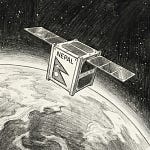Share the love! Help others that care about Nepal stay up to date the easy way. If you like this issue, share it with a friend who follows Nepal and hit Subscribe for your weekly dose of curated, can’t-miss updates.
As war flares abroad and smog thickens at home, Nepal is grappling with crises that span continents and generations. But through the haze—of pollution, stalled reforms, and geopolitical risk—Nepalis are organizing, adapting, and holding the line. Progress may be slow, but pressure is building where it counts.
Social & Cultural ⭐
Air pollution has quietly become Nepal’s deadliest public health threat, slashing life expectancy by 3.4 years and causing an estimated 26,000 premature deaths annually, according to a major new World Bank report, Towards Clean Air in Nepal. Fine particulate matter (PM2.5) in Kathmandu and the Tarai regularly exceeds the World Health Organization’s safe limits by more than sevenfold, putting millions at risk. The report, as detailed by KTM Post, links poor air quality to a range of chronic illnesses including heart disease, stroke, lung cancer, and even birth complications. Alarmingly, pollution now ranks above malnutrition and smoking as the top cause of death and disability in Nepal. Republica adds that the economic cost is staggering—over 6% of GDP—with rising health burdens and disruptions to tourism and productivity. Yet experts say solutions are well within reach: electrifying transport, modernizing industry, adopting clean cooking, and curbing forest fires could dramatically improve outcomes. The biggest hurdle, they warn, is not technology—but political will and coordinated action across sectors and borders.
Nepalis are also having fewer children than they want, not because of a shift in values but due to mounting social and financial pressures. A new UNFPA report shows that high living costs, job insecurity, and lack of childcare are major barriers, especially in urban areas like Bagmati and Gandaki. THT reports that while many families desire more children, fertility rates have dropped to just two per woman—largely due to a lack of economic stability and supportive policies. Republica notes that gender roles, labor migration, and inadequate parental leave are compounding the issue. Encouragingly, the report lays out a roadmap to empower reproductive choice: rights-based policies, flexible work, access to healthcare, and shared caregiving could help young Nepalis build the families they actually envision.
Meanwhile, climate vulnerability is reshaping daily life in Nepal’s cities. As Republica vividly reports, Kathmandu’s outdated drainage system is collapsing under stronger monsoons, poor planning, and bureaucratic turf wars. But there’s hope in a new study shared by KTM Post, which shows that parks, forests, and ponds can lower city temperatures by up to 1.6°C, easing urban heat stress. Thoughtful integration of green spaces into dense urban zones could be a low-cost, high-impact buffer. Elsewhere, THT reports widespread landslides and road blockages, but local recovery crews are already working to reopen key routes—an urgent reminder that resilience planning needs to be as local as the floods themselves.
Diaspora & Globalization 🌏
Nepal is scrambling to protect its citizens caught in the crossfire of the Israel-Iran conflict, with over 5,500 Nepalis currently living and working in Israel. After Iranian missile strikes on Tel Aviv and escalating military responses, the Nepali government has launched a wide-ranging emergency response. Republica reports that the Embassy in Tel Aviv has begun registering Nepalis for evacuation, while a Kathmandu Post investigation reveals deep logistical challenges—closed airports, blocked borders, and strained diplomatic corridors. A government-wide taskforce chaired by the Labour Secretary has outlined contingency measures, including rescue routes via third countries.
Amid these efforts, the Ministry of Foreign Affairs has issued a travel advisory, urging Nepalis in Israel and Iran to remain indoors and register their details online. The Embassy has also activated a 24-hour hotline, while the Non-Resident Nepali Association (NRNA) is coordinating response measures with embassy officials. So far, no casualties have been reported, but fear and uncertainty are rising—especially among undocumented workers. Authorities stress that the situation may evolve rapidly, and the priority remains ensuring communication, safety, and eventual return for those who wish to come home.
Meanwhile, tragedy struck the Nepali diaspora in the United States. A family of four—including two young children—was found dead in their Virginia apartment under mysterious circumstances. Kathmandu Post reports that Santosh Pariyar, his wife, and their two children were all victims of gunshot wounds. While U.S. police are still investigating, grieving relatives in Gorkha say they’ve been denied visas to attend the funeral. The incident has shaken the wider Nepali community in America, raising fresh questions around mental health, isolation, and the support systems available to migrant families abroad.
Economy & Development 💸
Nepal’s economic future may hinge on a new $2.3 billion roadmap, as the Asian Development Bank (ADB) unveiled its Country Partnership Strategy (CPS) for 2025–2029. The plan, jointly framed with the World Bank, prioritizes green, job-rich, and private sector–led growth—a critical shift as Nepal eyes graduation from least developed country status. According to Republica, the CPS also includes support for climate resilience, inclusive public services, and digital infrastructure, with room for co-financing and green bonds. KTM Post notes that Nepal’s reliance on remittances, weak exports, and low manufacturing productivity have left its economy vulnerable. But the ADB strategy offers a structural reset: integrating Nepal into global value chains, upgrading rural infrastructure, and investing in technical education to unlock its demographic dividend. If executed well, it could mark a long-awaited pivot from survival economics to sustainable competitiveness.
Complementing the ADB package, Nepal is also set to receive Rs 50.51 billion in soft loans and grants from the World Bank to upgrade strategic roads and bridges. As reported by THT, these funds will improve connectivity and trade routes, a long-standing bottleneck for rural development. Meanwhile, a smaller but symbolic financial closure has been achieved by the 7.9MW Chino Khola Hydropower Project in Manang, backed by Rs 1.35 billion in loans from Everest Bank. Republica highlights the milestone as a sign of growing confidence in small-to-midscale domestic energy ventures. Together, these moves show momentum building across infrastructure, energy, and financial systems—even as implementation capacity remains a challenge.
Other developments hint at long-term potential, if not immediate payoff. A preliminary Chinese-led survey in Dailekh has revealed over 1.12 billion cubic metres of methane gas, possibly enough to meet Nepal’s demand for decades. But as KTM Post and Nepal News caution, the results are early and commercial viability remains uncertain pending final tests due in December. On a more immediate front, Nepal Rastra Bank has approved the merger of IME Pay and Khalti, creating Nepal’s largest digital wallet with over 5 million verified users. THT reports that the unified platform—IME Khalti Limited—aims to expand access to fintech services nationwide, reduce cash dependency, and eventually integrate remittances, virtual banking, and credit into a single mobile ecosystem. If successful, it could be a leap forward in digital inclusion—especially in underbanked rural communities.
Politics & Governance 🪧
Uncertainty looms over the future of the $697 million MCC compact, as the U.S.-based Millennium Challenge Corporation faces sweeping global budget cuts and internal restructuring. A new proposal from MCC headquarters recommends slashing its global budget from $930 million to just $224 million—a move that could derail Nepal’s electricity transmission and road upgrade projects midway. Despite no formal cancellation notice, KTM Post reports that only a three-month work plan has been requested, leaving officials uncertain whether the compact will proceed as planned. The U.S. had committed $500 million, with Nepal contributing $197 million, and the five-year deadline is fast approaching. The budget proposal itself argues for MCC’s strategic importance in countering China’s Belt and Road Initiative, but offers no guarantees for Nepal. Former officials warn that without clear direction, the compact risks being quietly shelved—impacting infrastructure timelines and diplomatic trust alike.
Meanwhile, governance paralysis is also evident in Nepal’s own institutions. Despite ministerial orders and regulatory clearance, the Nepal Electricity Authority has failed to recover over Rs 8 billion in unpaid dues from industrialists who benefited from special trunk line connections during the power crisis years. As KTM Post reveals, NEA chief Hitendra Dev Shakya has taken no enforcement action, and even a review commission formed to evaluate the claims has yet to meet. This delay follows a history of political interference, including earlier efforts to protect non-paying firms and undermine former NEA chief Kulman Ghising. The episode underlines ongoing weaknesses in institutional accountability—especially when powerful interests are involved.
But not all government efforts are adrift. In climate diplomacy, Nepal is pressing ahead with its commitments from the Sagarmatha Sambaad, a global dialogue held in Kathmandu earlier this year. Republica reports that the Ministry of Forests and Environment has drafted an action plan to implement the forum’s 25-point "Sagarmatha Call", with a focus on justice for vulnerable groups and amplifying Himalayan voices in the climate conversation. While progress will depend on sustained coordination, the early steps reflect growing intent to link national environmental policy with global platforms—an encouraging sign as Nepal seeks to lead in mountain-focused climate advocacy.
Did you know ❓
Nepal once had its own airline company founded entirely by the Royal family—with a tiger as its logo.
Back in 1958, Royal Nepal Airlines Corporation (RNAC) was launched as Nepal’s first airline, with direct involvement from the monarchy. It wasn’t just symbolic—the first aircraft, a Douglas DC-3, was personally received by King Mahendra. The airline's iconic tiger logo came from the king’s hunting banner, not a marketing agency.
Despite its now-struggling successor (Nepal Airlines), RNAC once flew to Europe, Southeast Asia, and the Middle East, making Kathmandu a regional aviation hub well before Tribhuvan Airport got a modern terminal.
Let’s connect
Enjoying this issue? 📩 Share it with a friend & let’s keep Nepalis worldwide in the loop! Got thoughts? Hit reply—we’re all ears! Or let us know what you think via our Feedback form or follow us on Facebook | LinkedIn
P.S. Got a story or issue you'd like us to cover next week? Drop us a reply — we're building this space together.
About Nepali Diaspora Digest:
The Nepali Diaspora Digest connects the global Nepali community with curated news, insights, and stories that matter most. Join us as we celebrate and explore the diverse voices and achievements of Nepalis worldwide.
Partner shout out
belayat.uk: helping Nepalis connect in the UK on jobs, housing, events and finding local Nepali owned businesses













